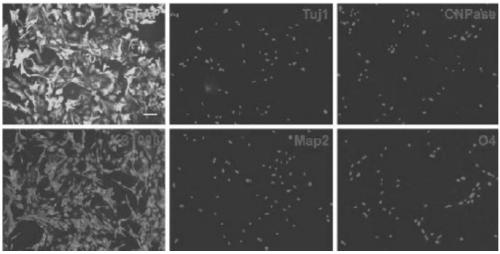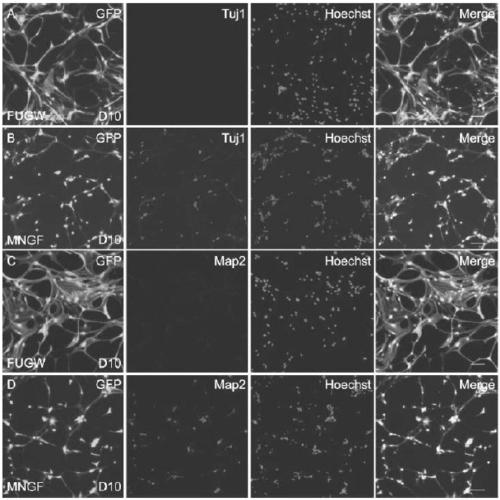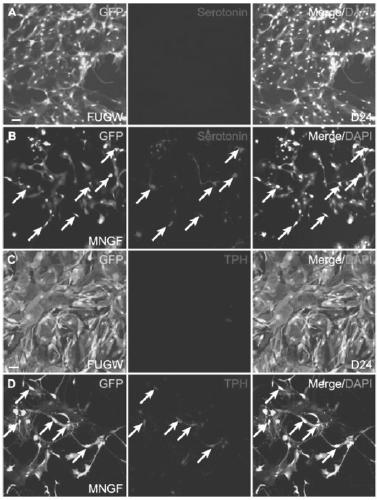Method for inducing astrocytes to transdifferentiate into 5-hydroxytryptaminergicneuron and application
A kind of astrocyte, serotonin technology, applied in biological field
- Summary
- Abstract
- Description
- Claims
- Application Information
AI Technical Summary
Problems solved by technology
Method used
Image
Examples
Embodiment 1
[0121] Example 1. Screening for transcription factors to induce serotonergic neurons
[0122] 1. Isolation and purification of astrocytes
[0123] In order to induce the reprogramming of astrocytes to produce serotonergic neurons, the inventors combined a series of transcription factors (Ascl1, Nkx2.2, Gata2, Gata3, Foxa2, Lmx1b, Pet1, Insm1, Sim1) were cloned into the lentiviral vector as candidate genes. The transcription factors were all expressed through the Ubiquitin promoter, a ubiquitous promoter on the FUGW lentiviral vector. The FUGW vector expressing the reporter gene EGFP alone was used as the control group. Astrocytes from the dorsal midbrain of postnatal day 5 (P5) mice were collected, isolated and purified, and used as the initial cells for transcription factor-induced 5-HTergic neurons. The purity of the starting cells was detected by immunofluorescent staining of astrocyte-specific marker molecules GFAP and S100β ( figure 1 ). Approximately 85% and 97% of ...
Embodiment 2
[0144] Example 2. Comparison of electrophysiological characteristics between induced serotonergic neurons and in vivo serotonergic neurons
[0145] The inventors prepared acutely dissociated brain slices of the raphe nucleus of TPH2-iCreERT2-tdTomato knock-in mice at postnatal day 28-32, and recorded the electrophysiological properties of tdTomato-positive serotonergic neurons ( Figure 9 A). It was found that the five serotonergic neurons (iSNs) generated after 41 days of induction by five transcription factors (M5) could be compared with the serotonergic neurons (Native ) generate similar action potentials ( Figure 9 A, B). Statistical action potential complexity found that there was no significant difference in the proportion of cells capable of generating multiple action potentials between the two ( Figure 9 C). The frequency adaptation of the action potential (spikefrequency accommodation, SFA). There was no significant difference in the SFA values of serotonerg...
Embodiment 3
[0148] Embodiment 3, optimizing culture condition improves induction efficiency and maturity
[0149] 1. Add small molecules to optimize culture conditions
[0150] Obtaining enough serotonergic neurons in an in vitro culture dish is important for studying their functions, and has the potential to improve diseases caused by dysfunction of serotonergic neurons. The present inventors tried to add small molecules (Small molecules, SM) to the induction medium, and tested whether the addition of small molecules could improve the efficiency of inducing serotonergic neurons. In the induction system for transdifferentiation to obtain serotonergic neurons, the inventors added the neurotrophic factor BDNF (20ng / ml ). The small molecule medium is based on the induction medium, and Y27632 (10 μM), PD0332991 (1 μM), neurotrophic factors GDNF (20ng / ml) and BDNF (20ng / ml) are added throughout the induction process. On day 9, the small molecules Dorsomorphin (0.5 μM) and SB431542 (5 μM) we...
PUM
| Property | Measurement | Unit |
|---|---|---|
| electrical resistance | aaaaa | aaaaa |
| diameter | aaaaa | aaaaa |
Abstract
Description
Claims
Application Information
 Login to View More
Login to View More - R&D
- Intellectual Property
- Life Sciences
- Materials
- Tech Scout
- Unparalleled Data Quality
- Higher Quality Content
- 60% Fewer Hallucinations
Browse by: Latest US Patents, China's latest patents, Technical Efficacy Thesaurus, Application Domain, Technology Topic, Popular Technical Reports.
© 2025 PatSnap. All rights reserved.Legal|Privacy policy|Modern Slavery Act Transparency Statement|Sitemap|About US| Contact US: help@patsnap.com



